As many will tell you, sport physical therapists see a wide range of different patient issues. Anything from torn ACLs in the process of healing to chronic pain in every variety. As an injury that continues to garner a considerable amount of concern from the medical community, concussions are in the headlines once again with some alarming new studies regarding football and CTE.
Football and CTE | What’s the Damage?
A neuropathological study of brains donated by deceased football players has revealed a startling connection between playing football and a degenerative brain disease known as chronic traumatic encephalopathy (CTE). Of the 202 brains, 111 belonged to former NFL players — and all but one displayed signs warranting a diagnosis of CTE.
In light of these new studies, football and CTE are likely to remain quite a controversial topic. Beyond the fact that this disease can be responsible for symptoms like depression, confusion, memory loss, and dementia, it’s now also correlated to one of the most popular and lucrative American past times ever invented. The highlighted relationship between this disease and the sport will undoubted cause some turbulence for both the medical community and pro-sports leagues.

So, what is CTE exactly and why is football on the chopping block? Chief of neuropathology at the VA Boston Healthcare System and director of the CTE Center at Boston University, Dr. Ann McKee led the study examining the effects that repeated blows to the head can have on football players. These results were just recently published in The Journal of the American Medical Association, offering a critical insight into just how traumatic this sport can be.
Looking at the Data:
Of the 202 deceased former football players studied, their average age was 66 years old, with 177 receiving a clinical diagnosis for CTE. Breaking down the numbers, there are some significant pieces of information found within this study. For instance, 91% of the 53 college athletes, 64% of the 14 semi-professional athletes, and 88% of the 8 Canadian Football League athletes appeared to have CTE.
All but one of the remaining 111 brains (99%) belonging to National Football League players displayed a neuropathological diagnosis of CTE.
Although this may seem incredibly shocking given these numbers, Dr. McKee acknowledged the tremendous selection bias present in the study. She told The New York Times that many of the donated brains were likely donated due to the fact that these former players presented symptoms of CTE prior to their deaths. Still, any diagnosis with such a significant percentage of the subjects confirming the hypothesis is cause for discussion.
Writers from the New York Times commented that “About 1,300 former players have died since the B.U. group began examining brains. So even if every one of the other 1,200 players had tested negative — which even the heartiest skeptics would agree could not possibly be the case — the minimum CTE prevalence would be close to 9 percent, vastly higher than in the general population.”
Changes to Come?
To put it simply, this study revealed that the longer players stayed in the sport, the more likely they were to develop CTE. The leap from high school to college athletes showed the most severe pathology, along with the vast majority semi-pro and pro players. So, what does this mean for football players and the medical professionals treating them? Will this lead to a shift in how parents feel about letting their children play the sport? How will the NFL respond?
Just two days after the study was published, John Urschel of the Baltimore Ravens announced his retirement from the sport at age 26, citing concerns about these findings. It remains to be seen how other players will voice their concerns about playing football and CTE, despite the millions of dollars backing their contracts and their dedication to the sport.

